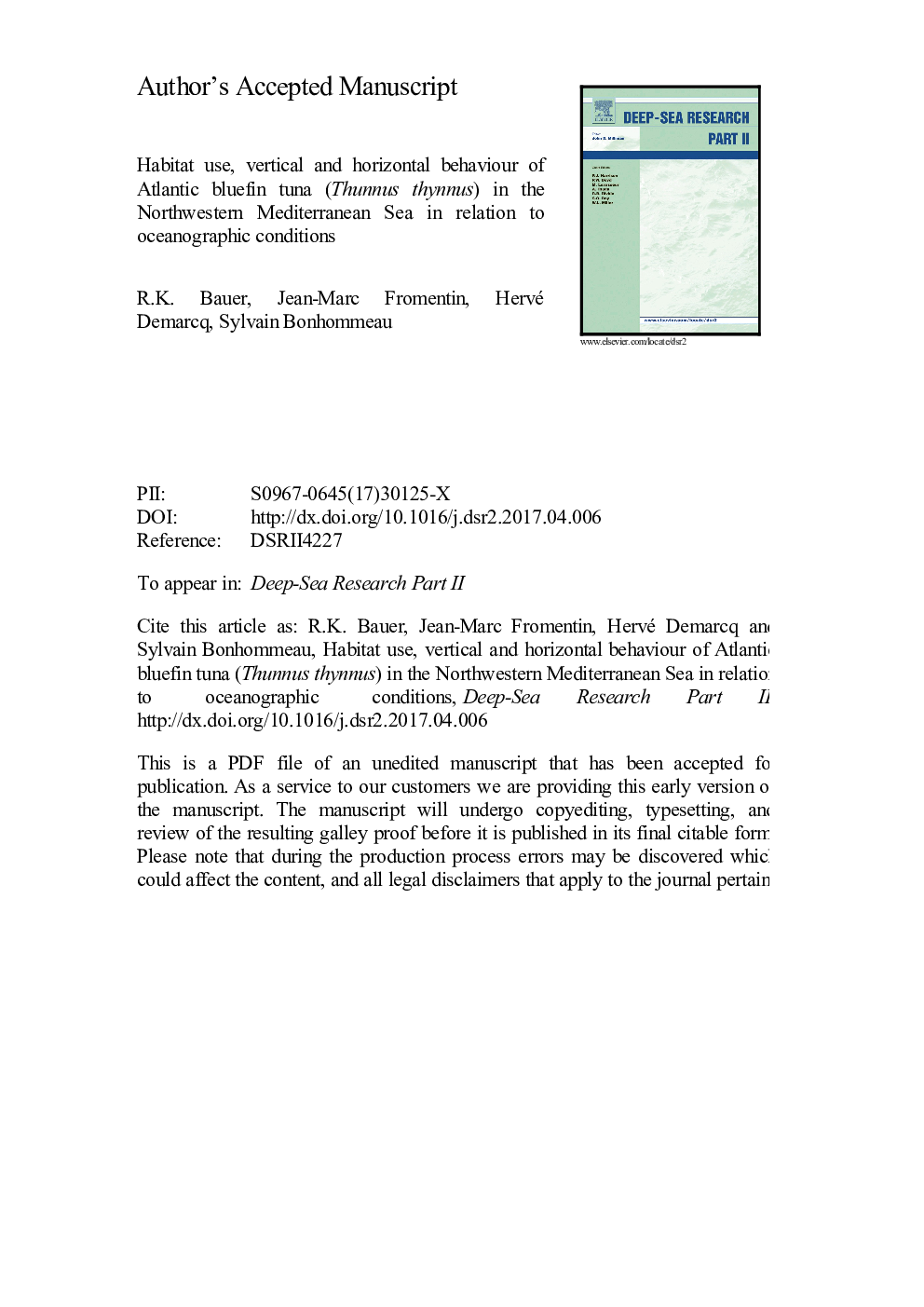| کد مقاله | کد نشریه | سال انتشار | مقاله انگلیسی | نسخه تمام متن |
|---|---|---|---|---|
| 5764936 | 1626401 | 2017 | 45 صفحه PDF | دانلود رایگان |
عنوان انگلیسی مقاله ISI
Habitat use, vertical and horizontal behaviour of Atlantic bluefin tuna (Thunnus thynnus) in the Northwestern Mediterranean Sea in relation to oceanographic conditions
دانلود مقاله + سفارش ترجمه
دانلود مقاله ISI انگلیسی
رایگان برای ایرانیان
کلمات کلیدی
موضوعات مرتبط
مهندسی و علوم پایه
علوم زمین و سیارات
زمین شناسی
پیش نمایش صفحه اول مقاله

چکیده انگلیسی
We investigated the habitat utilization, vertical and horizontal behaviour of Atlantic bluefin tuna Thunnus thynnus (ABFT) in relation to oceanographic conditions in the northwestern Mediterranean Sea, based on 36 pop-up archival tags and different environmental data sets. Tags were deployed on early mature ABFT (127-255 cm) between July and November in 2007-2014, on the shelf area off Marseille, France. The data obtained from these tags provided 1643 daily summaries of ABFT vertical behaviour over 8 years of tag deployment. Based on a hierarchical clustering of this data, we could identify four principle daily vertical behaviour types, representing surface (â¦10m) and subsurface (10-100 m) orientation, moderate (50-200 m) and deep (â§200m) diving behaviour. These vertical behaviour types showed seasonal variations with partly opposing trends in their frequencies. Accordingly, ABFT were more surface orientated during summer, while moderate diving behaviour was more common during winter. Depth time series data further revealed inverted day-night patterns for both of these periods. Tagged ABFT frequented the surface waters more regularly during daytime and deeper waters during the night in summer, while the opposite pattern was found in winter. Seasonal changes in the vertical behaviour of ABFT were accompanied by simultaneous changes in environmental conditions (SST, chla, thermal stratification). Accordingly, surface orientation and moderate diving behaviour appeared to be triggered by the thermal stratification of the water column, though less pronounced than previously reported for ABFT in the North Atlantic, probably indicating adaptive vertical behaviour related to the availability of epipelagic food resources (anchovies and sardines). Deep diving behaviour was particularly frequent during months of high biological productivity (February-May), although one recovered tag showed periodic and unusual long spike dives during summer-autumn, in relation to thermal fronts. Regional effects on the vertical behaviour of ABFT were identified through GAMs, with surface orientation being particularly pronounced in the Gulf of Lions, highlighting its suitability for an ongoing annual aerial survey program to estimate ABFT abundance in this region. In addition, increased levels of mesoscale activity/productivity (e.g. related to oceanic fronts) were detected in an area regularly utilized by ABFT, south of the Gulf of Lions, underlining its attractiveness as foraging ground. Kernel densities of geolocation estimates showed a seasonal shift in the horizontal distribution of ABFT from this “high-use” area towards the Gulf of Lions during summer, probably linked to the enhanced availability of epipelagic food resources at this time.
ناشر
Database: Elsevier - ScienceDirect (ساینس دایرکت)
Journal: Deep Sea Research Part II: Topical Studies in Oceanography - Volume 141, July 2017, Pages 248-261
Journal: Deep Sea Research Part II: Topical Studies in Oceanography - Volume 141, July 2017, Pages 248-261
نویسندگان
Robert Klaus Bauer, Jean-Marc Fromentin, Hervé Demarcq, Sylvain Bonhommeau,